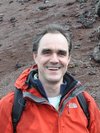
The aim of the project was to yield an image of the subduction process of the NAZCA plate underneath South America. To obtain information about the velocity too, a combined near-vertical, wide-angle reflection/refraction seismic investigation was carried out. The profile stretched W-E at 21° S for 370 km from the coast of the Pacific ocean (Chile) until the Altiplano in Bolivia. 252 seismic channels were deployed. The applied shot scheme resulted in a four fold coverage. The main features imaged were the Nazca reflector in a depth from about 70 to 80 km and the so called Quebrada Blanca bright spot about 130-150 km east of the coast in a depth of about 30-40km. The wide-angle reflection studies provided the velocity information showing typical crustal velocities below the volcanic arc (Western Cordillera) down to about 70 km. In the eastern part (Altiplano) rather low velocities prevail in the upper crust. The 6.1 km/s isoline is in a depth of about 15 km. These results were interpreted together with seismological findings to explain petrological processes like dehydration and metamorphism in the downgoing slab and their possible relation to the active volcanism.
Time Frame
- September - December 1996
Principal Investigators
- Dr. Ch. Haberland (GFZ Potsdam)
- Dr. G. Asch (GFZ Potsdam)
- Prof. P. Giese, Dr. P. Wigger (Freie Universitaet Berlin)
- Dr. A. Schulze (GFZ Potsdam)
Project Website
- For detailed information about the near-vertical seismic experiment see ANCORP96 under DEKORP.
Cooperations
- Guillermo Chong, Universidad Catolica del Norte Antofagasta, Chile
Methods & Equipment
- Near vertical and wide angle seismic measurements using 28 six channel and 28 3 channel recorders from the GIPP and the Freie Universitaet Berlin.
Publications/Results
- The ANCORP Working Group: Seismic reflecrion image revealing offset Andean subduction-zone earthquake locations into oceanic mantle (1999): NATURE, Vol. 397
- ANCORP Working Group: Seismic imaging of a convergent continental margin and plateau in the central Andes (Andean Continental Research Project 1996 (ANCORP'96)) (2003): J. Geophys. Res., 108(7), 2328, doi:10.1029/2002JB001771




